Elastodontic Therapy with Oral Bioactivator Devices: A Review
Abstract
:1. Introduction
2. Material and Methods
3. Elastodontic Therapy
3.1. The Story
3.2. The Indications
- -
- Skeletonically malpositioned dental arches of a second-class type craniomandibular character, third grades, laterally deviated arches, twisted, deep bites, and open bites;
- -
- Dental elements misaligned in the arches;
- -
- Postural imbalances;
- -
- Tension decompensation of a neuromuscular nature;
- -
- Joint decompensation (TMJ);
- -
- Atypical swallowing;
- -
- Mouth breathing;
- -
- Bruxism [5];
- -
- OSAS [14].
4. Elastodontic Appliances
4.1. Description of the Device
- -
- Vestibular and lingual flanges form with a free area in the middle where the indentation is absent, and teeth are positioned by an occlusal plane in I-class normocclusion. The vestibular flanges extend up to the border, with the fornixes performing a lip-bumper type function and stimulating proprioceptively the matrix bone. The two arches are thus involved simultaneously, carrying out a multidimensional orthopaedic action in a vertical, transverse, sagittal, and torsional direction;
- -
- Indicators: are located on the buccal flange and are helpful in detecting the size of the device;
- -
- Concavity: used at the level of the canine drafts to avoid bone interference;
- -
- Lingual ramp: used to guide the tongue on the palatal spot;
- -
- Lingual button: used to correct the position of the tongue.
4.2. Classification
- -
- Class I bioactivator: used in deciduous, mixed, and permanent dentition to correct arch deviations by correcting the midlines to correct bad habits; it determines a pre-alignment of the teeth and is also used as a restraint after multibracket therapy and basal skeletal disharmonies such as horizontal, transverse, and vertical deficits, such as open or deep bites, and is designed in two different occlusal planes: BASIC: equipped with a raised anterior plane suitable for deep bites and INTEGRAL: equipped with a uniform plane anteriorly and posteriorly used to treat alterations in occlusal curves. Four models can be distinguished based on the different arches and facial biotype forms: F for ogival arches in the dolicofacial arches, S for more rounded arches in the mesofacial, OS for square-shaped arches in the mesofacial, and C for wide dental arches in the brachifacial [5] (Figure 2 and Figure 3):
- -
- -
- Class III TC bioactivator: Used for skeletal Class III and pseudo-Class III. It has an anterior sliding plane that guides the correct position of the upper incisors, and it exercises posterior pressure on the mandible to limit its excessive growth. It eliminates the centripetal force of the orbicular muscle and the tongue’s centrifugal force to restore normal muscular function. [5] (Figure 2);
- -
- ElastoOsas bioactivator: Made to clear the respiratory tract by reducing snoring at night and also indicated in cases of bruxism, neuromuscular tension problems, and muscle tension headaches. It has a guide to the lower arch, which is more protruded, a raised occlusal plane, and a lingual ramp that acts as a lingual elevator (accompanies the tongue towards the button in the palatine area) [5] (Figure 4);
- -
- These elements allow the recovery of correct nasal breathing as they free the pharyngeal area;
- -
- Open bioactivator: Indicated for the treatment of skeletal anterior open bites. The device has a raised rear surface as a specific thrust on the posterior molars. The plane has a “fulcrum” action causing an anteroflexion of the occlusal plane, restoring it horizontally. Contraindicated for ATM-specific problems [5] (Figure 4);
- -
- Integral Plus bioactivator: It has a guide in the inner wall of the upper and lower flange for housing the brackets. It aims to improve the teeth’s alignment and functional, skeletal, joint, and neuromuscular problems. It cannot be used with steel arches, reverse arches, inter-arch elastics, or in the presence of occlusal rises [5] (Figure 4);
- -
- Bioactivator for deciduous teeth: Used in deciduous dentition, indicated to correct deviations of the dental arches, mono and bilateral crossbites, anterior open bites, correct bad habits, improve swallowing and breathing, and night grinding. There are two models: DC (with a pacifier) and D (without a pacifier) [5] (Figure 5).
4.3. Treatment protocol
4.4. Exercises
4.5. Advantages and Limits
5. Discussion and Conclusions
Author Contributions
Funding
Institutional Review Board Statement
Informed Consent Statement
Data Availability Statement
Conflicts of Interest
References
- Fichera, G.; Martina, S.; Palazzo, G.; Musumeci, R.; Leonardi, R.; Isola, G.; Lo Giudice, A. New Materials for Orthodontic Interceptive Treatment in Primary to Late Mixed Dentition. A Retrospective Study Using Elastodontic Devices. Materials 2021, 14, 1695. [Google Scholar]
- Macrì, M.; Toniato, E.; Murmura, G.; Varvara, G.; Festa, F. Midpalatal Suture Density as a Function of Sex and Growth-PatternRelated Variability via CBCT: Evaluations of 392 Adolescents Treated with a Rapid Maxillary Expander Appliance. Appl. Sci. 2022, 12, 2221. [Google Scholar]
- Tafazoli Moghadam, E.; Yazdanian, M.; Alam, M.; Tebyanian, H.; Tafazoli, A.; Tahmasebi, E.; Ranjbar, R.; Yazdanian, A.; Seifalian, A. Current natural bioactive materials in bone and tooth regeneration in dentistry: A comprehensive overview. J. Mater. Res. Technol. 2021, 13, 2078–2114. [Google Scholar]
- Macrì, M.; Festa, F. Three-dimensional evaluation using CBCT of the mandibular asymmetry and the compensation mechanism in a growing patient: A case report. Front. Public Health 2022, 10, 921413. [Google Scholar] [CrossRef] [PubMed]
- Wahl, N. Orthodontics in 3 millennia. Chapter 9: Functional appliances to midcentury. Am. J. Orthod. Dentofac. Orthop. 2006, 129, 829–833. [Google Scholar]
- Besomber, A.; Soulet, R. A new instrument in simplified functional orthopaedic treatment. Rev. Fr. Odontostomatol. 1955, 2, 483–490. [Google Scholar]
- Bergersen, E.O. Preventive eruption guidance in the 5-to-7-year-old. J. Clin. Orthod. 1995, 29, 382–395. [Google Scholar]
- Myrlund, R.; Dubland, M.; Keski-Nisula, K.; Kerosuo, H. One year treatment effects of the eruption guidance appliance in 7- to 8-year-old children: A randomized clinical trial. Eur. J. Orthod. 2015, 37, 128–134. [Google Scholar] [CrossRef] [Green Version]
- Macrì, M.; Murmura, G.; Scarano, A.; Festa, F. Prevalence of temporomandibular disorders and its association with malocclusion in children: A transversal study. Front. Public Health 2022, 2022, 860833. [Google Scholar] [CrossRef]
- Marra, P.; Fiorillo, L.; Cervino, G.; Cardarelli, F.; Cicciù, M.; Laino, L. Elastodontic treatment with oral bio-activators in young children. Minerva Dent. Oral Sci. 2022, 71, 270–276. [Google Scholar] [CrossRef]
- Esteve-Altava, B.; Rasskin-Gutman, D. Beyond the functional matrix hypothesis: A network null model of human skull growth for the formation of bone articulations. J. Anat. 2014, 225, 306–316. [Google Scholar] [CrossRef]
- Chen, Y.; Hagg, U.; McGrath, C. Elastodontic appliance assisted fixed appliance treatment: A new two-phase protocol for extraction cases. J. Orthod. 2019, 46, 251–258. [Google Scholar] [CrossRef]
- Balian, A.; Malerba, A.; Strohmenger, L. Obstructive Sleep Apnea Syndrome (OSAS) Treated with Orthodontic Appliances in Children: A New Feasible Approach. Ann. Dent. Oral Disord. 2018, 1, 105. [Google Scholar]
- Aprile, G.; Ortu, E.; Cattaneo, R.; Pietropaoli, D.; Giannoni, M.; Monaco, A. Orthodontic Management by Functional Activator Treatment: A Case Report. J. Med. Case Rep. 2017, 11, 336. [Google Scholar] [CrossRef] [Green Version]
- Lim, J.; McKean, M. Adenotonsillectomy for Obstructive Sleep Apnea in Children (Cochrane Review); The Cochrane Library: Oxford, UK, 2003. [Google Scholar]
- Tauman, R.; Gulliver, T.E.; Krishna, J.; Montgomery-Downs, H.E.; O’brien, L.M.; Ivanenko, A. Gozal.Persistence of obstructive sleep apnea syndrome in children after adenotonsillectomy. J. Pediatr. 2006, 149, 803–808. [Google Scholar] [CrossRef]
- Quinzi, V.; Gallusi, G.; Carli, E.; Pepe, F.; Rastelli, E.; Tecco, S. Elastodontic Devices in Orthodontics: An In-Vitro Study on Mechanical Deformation under Loading. Bioengineering 2022, 9, 282. [Google Scholar] [CrossRef] [PubMed]
- Macrì, M.; Medori, S.; Varvara, G.; Festa, F. A Digital 3D Retrospective Study Evaluating the Efficacy of Root Control during Orthodontic Treatment with Clear Aligners. Appl. Sci. 2023, 13, 1540. [Google Scholar] [CrossRef]
- Macrì, M.; Murmura, G.; Varvara, G.; Traini, T.; Festa, F. Clinical performances and biological features of clear aligners materials in orthodontics. Front. Mater. 2022, 9, 819121. [Google Scholar] [CrossRef]
- Keski-Nisula, K.; Hernesniemi, R.; Heiskanen, M.; Keski-Nisula, L.; Varrela, J. Orthodontic intervention in the early mixed dentition: A prospective, controlled study on the effects of the eruption guidance appliance. Am. J. Orthod. Dentofac. Orthop. 2008, 133, 254–260. [Google Scholar] [CrossRef]
- Macrì, M.; Rendina, F.; Feragalli, B.; Pegreffi, F.; Festa, F. Prevalence of Ponticulus Posticus and Migraine in 220 Orthodontic Patients: A Cross-Sectional Study. Biology 2023, 12, 471. [Google Scholar] [CrossRef] [PubMed]
- Festa, F.; Rotelli, C.; Scarano, A.; Navarra, R.; Caulo, M.; Macrì, M. Functional Magnetic Resonance Connectivity in Patients With Temporomadibular Joint Disorders. Front. Neurol. 2021, 12, 629211. [Google Scholar] [CrossRef] [PubMed]
- Ortu, E.; Pietropaoli, D.; Cova, S.; Marci, M.C.; Monaco, A. Efficacy of elastodontic devices in overjet and overbite reduction assessed by computer-aid evaluation. BMC Oral Health 2021, 21, 269. [Google Scholar] [CrossRef]
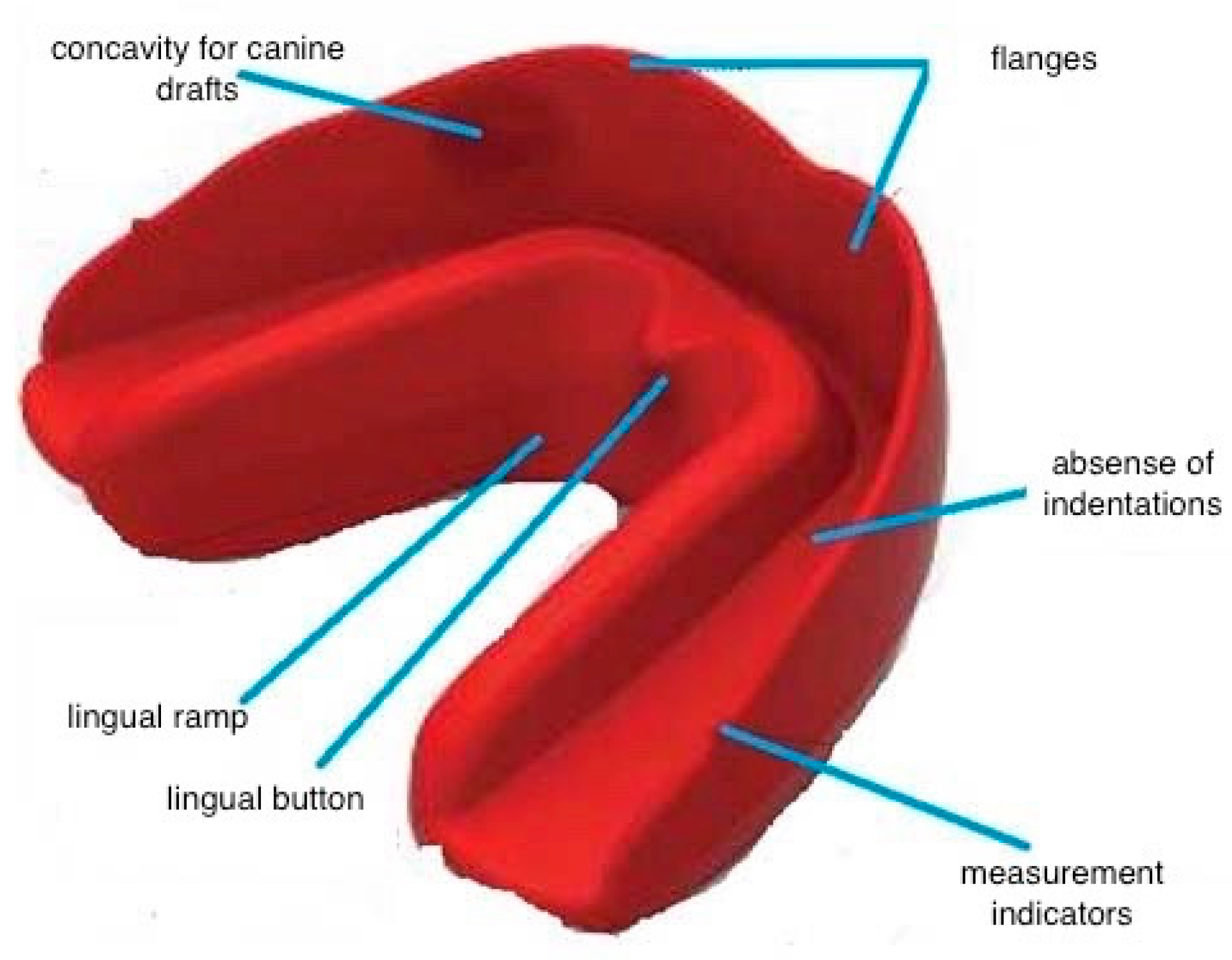
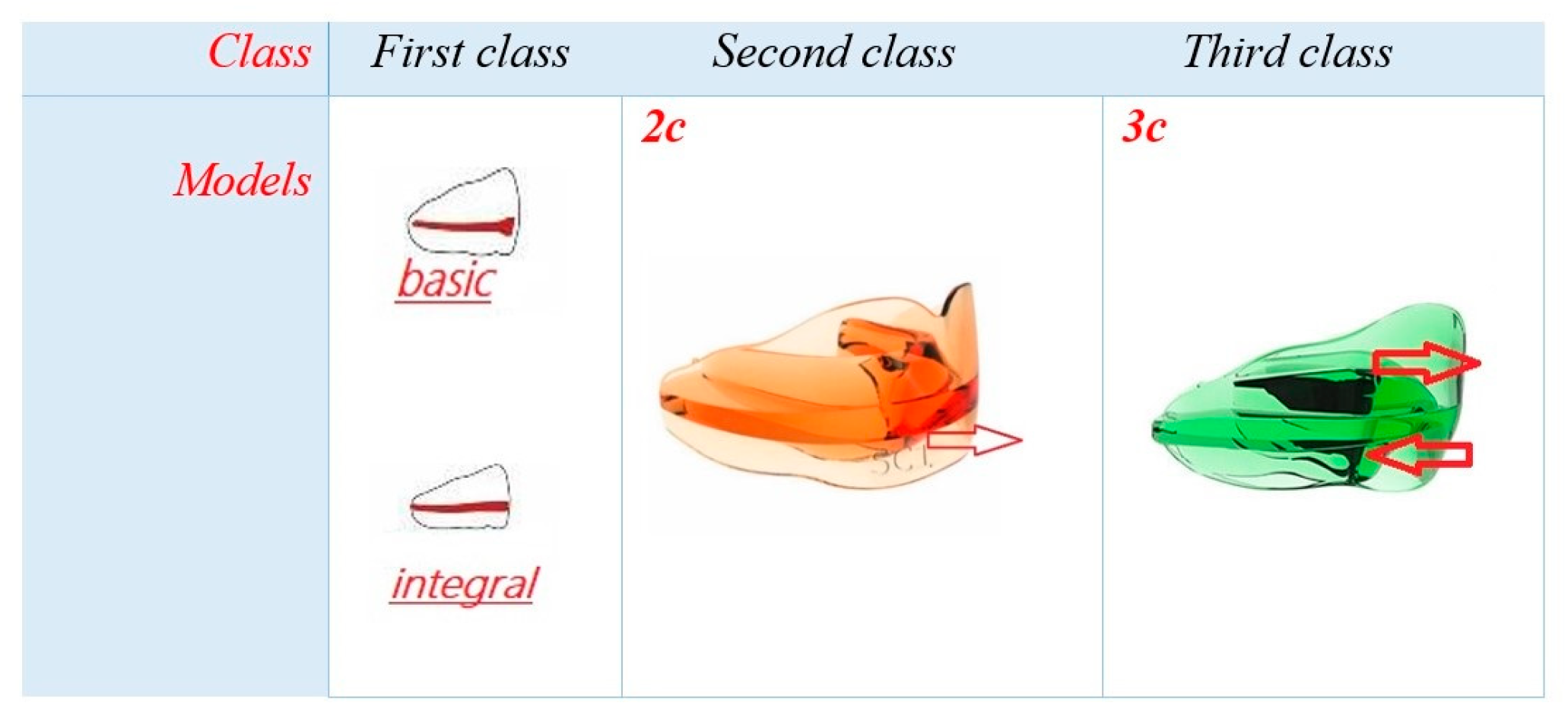
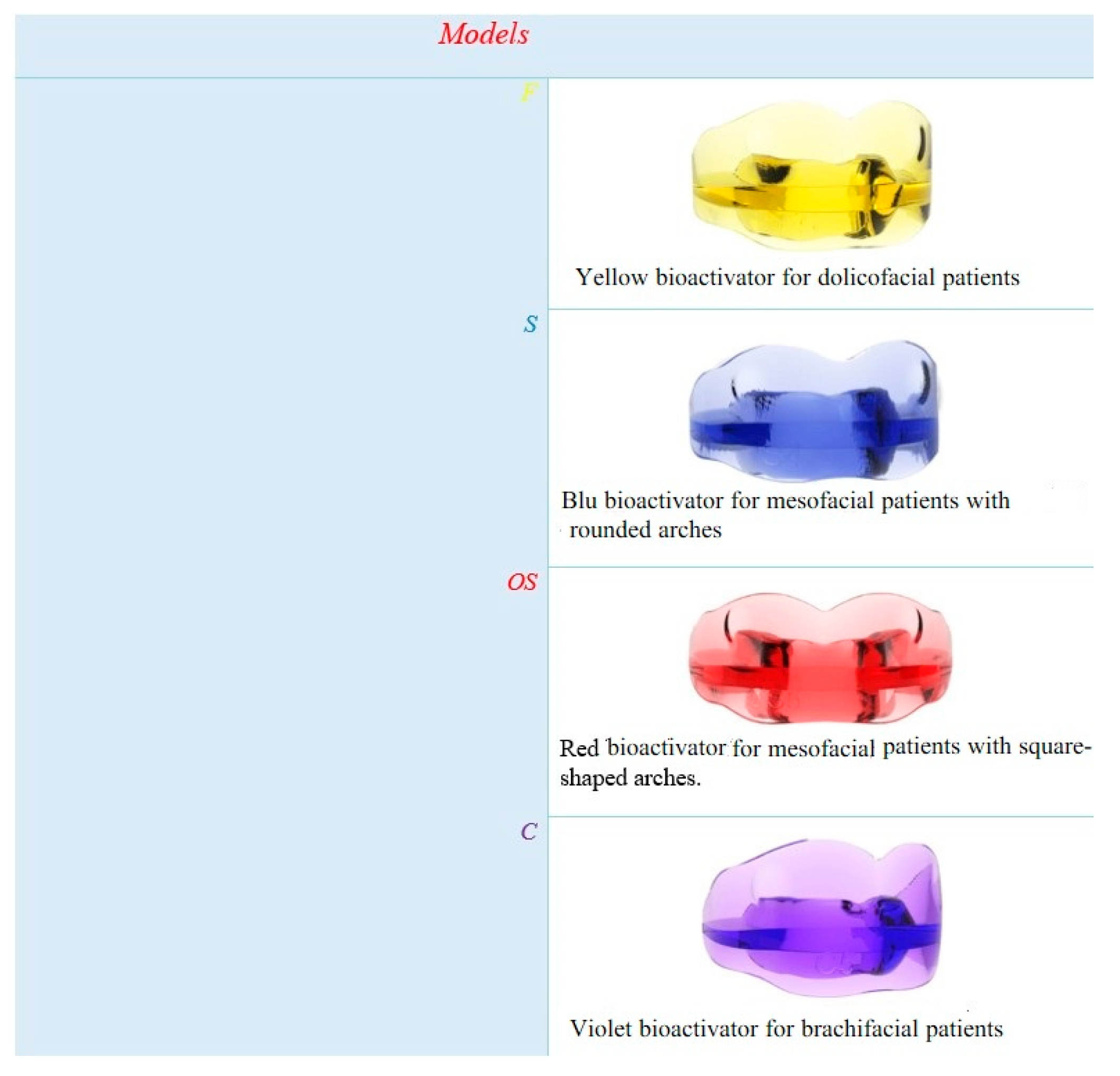
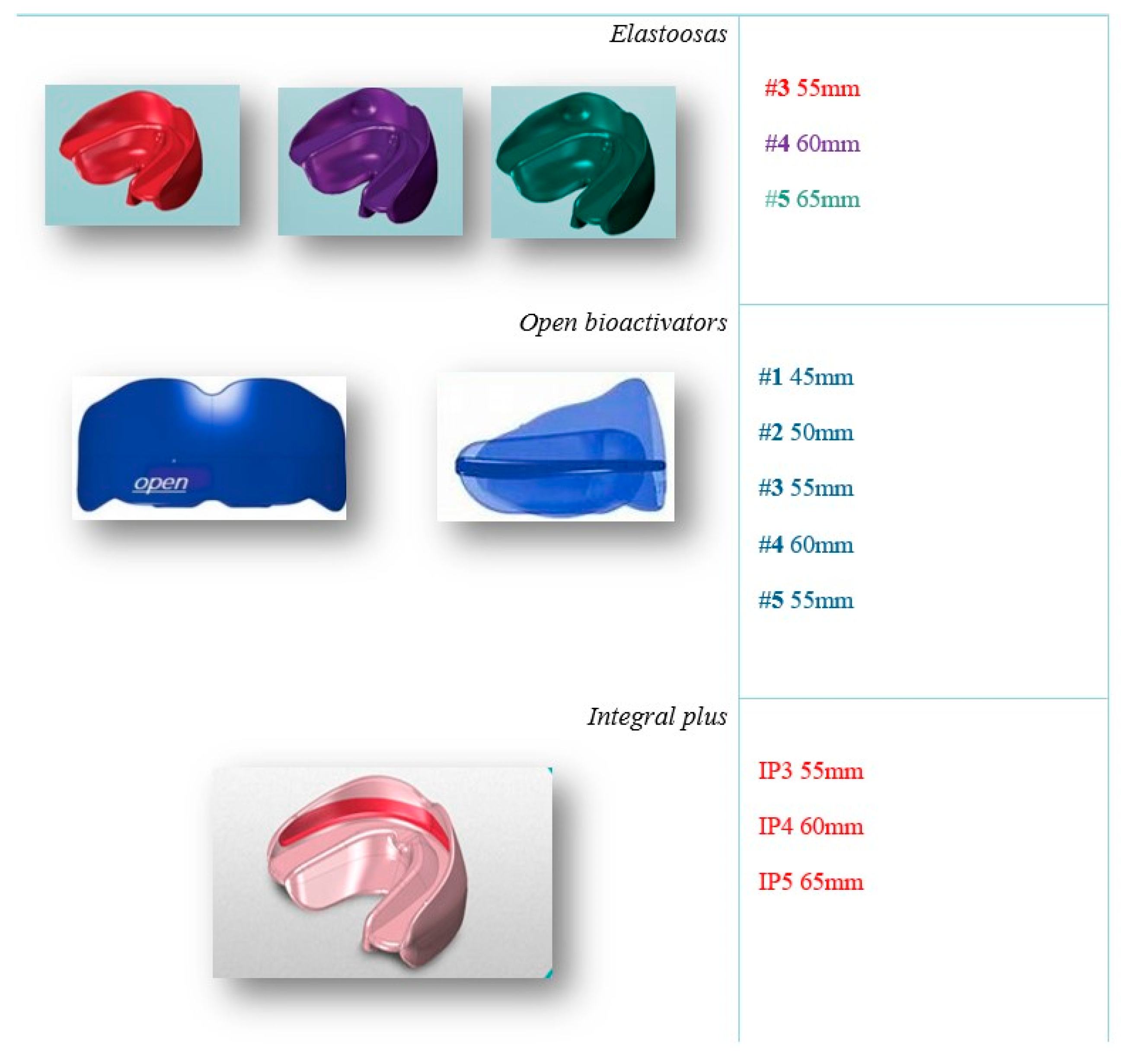
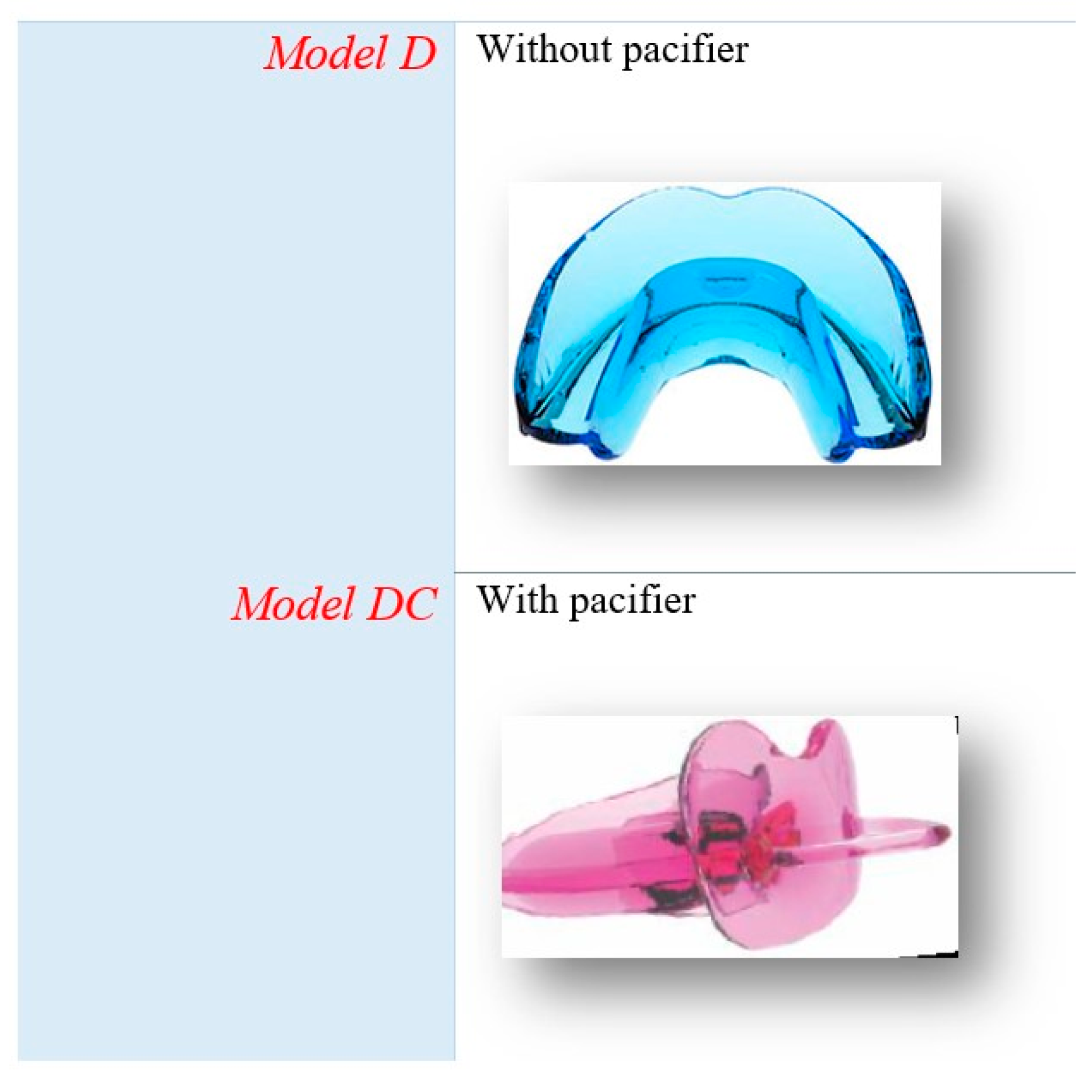


Disclaimer/Publisher’s Note: The statements, opinions and data contained in all publications are solely those of the individual author(s) and contributor(s) and not of MDPI and/or the editor(s). MDPI and/or the editor(s) disclaim responsibility for any injury to people or property resulting from any ideas, methods, instructions or products referred to in the content. |
© 2023 by the authors. Licensee MDPI, Basel, Switzerland. This article is an open access article distributed under the terms and conditions of the Creative Commons Attribution (CC BY) license (https://creativecommons.org/licenses/by/4.0/).
Share and Cite
Macrì, M.; Ritrovato, L.; Pisanelli, E.L.; Festa, F. Elastodontic Therapy with Oral Bioactivator Devices: A Review. Appl. Sci. 2023, 13, 8868. https://doi.org/10.3390/app13158868
Macrì M, Ritrovato L, Pisanelli EL, Festa F. Elastodontic Therapy with Oral Bioactivator Devices: A Review. Applied Sciences. 2023; 13(15):8868. https://doi.org/10.3390/app13158868
Chicago/Turabian StyleMacrì, Monica, Luisa Ritrovato, Elena Lucia Pisanelli, and Felice Festa. 2023. "Elastodontic Therapy with Oral Bioactivator Devices: A Review" Applied Sciences 13, no. 15: 8868. https://doi.org/10.3390/app13158868





